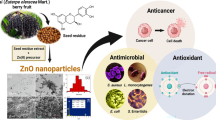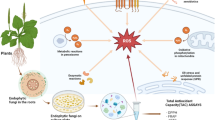Abstract
Light and bacteria can be used in combination to enhance secondary metabolite production during fermentation. Red yeast rice powder (RYRP) was inoculated with Bacillus subtilis (B2) isolated from freshwater seafood and incubated under light-emitting diodes (LEDs) of different colors (blue, green, red, white), fluorescent white light, and in darkness. Blue LED-mediated fermentation with B2 significantly enhanced production of phenolic compounds (68.4 ± 1 mg GAE/g DW) and flavonoids (51.7 ± 1 mg QE/g DW) compared to white light and darkness. Total antioxidant activity of RYRP extract after fermentation with B2 was > 77%; hydroxyl radical and superoxide scavenging were > 66%. DPPH (2,2-diphenyl-1-picryl-hydrazyl-hydrate) and ABTS (2,2′-azino-bis (3-ethylbenzothiazoline-6-sulphonic acid)) radical scavenging activities were 51% and > 67%, respectively. Reducing power was approximately twice that of extract from RYRP without B2. FTIR analysis showed a high content of hydroxyl, nitrile and carboxylic groups in the extract. Derivatives of cinnamic, benzoic and phophinodithioic acid, and quinazolinone were identified by GC–MS. Findings show that fermenting RYRP with B. subtilis B2 under blue LEDs enhances production of secondary metabolites, which should have applications in industrial fermentation processes.







Similar content being viewed by others
References
Gomelsky M, Hoff WD (2011) Light helps bacteria make important lifestyle decisions. Trends Microbiol 19:441–448. https://doi.org/10.1016/j.tim.2011.05.002
van der Horst MA, Key J, Hellingwerf KJ (2007) Photosensing in chemotrophic, non-phototrophic bacteria: let there be light sensing too. Trends Microbiol 15:554–562. https://doi.org/10.1016/j.tim.2007.09.009
Davis SJ, Vener AV, Vierstra RD (1999) Bacteriophytochromes: phytochrome-like photoreceptors from nonphotosynthetic eubacteria. Science 286:2517–2520. https://doi.org/10.1126/science.286.5449.2517
Darko E, Heydarizadeh P, Schoefs B, Sabzalian MR (2014) Photosynthesis under artificial light: the shift in primary and secondary metabolism. Philos Trans R Soc B Biol Sci 369:20130243–20130243. https://doi.org/10.1098/rstb.2013.0243
Margit Olle AV (2013) The effect of light-emitting diode lighting on greenhouse plant growth and quality. Agric Food Sci 22:223–234. https://doi.org/10.1016/j.envexpbot.2009.06.011
Ma R, Thomas-Hall SR, Chua ET et al (2018) LED power efficiency of biomass, fatty acid, and carotenoid production in Nannochloropsis microalgae. Bioresour Technol 252:118–126. https://doi.org/10.1016/j.biortech.2017.12.096
Katsuda T, Lababpour A, Shimahara K, Katoh S (2004) Astaxanthin production by Haematococcus pluvialis under illumination with LEDs. Enzyme Microb Technol 35:81–86. https://doi.org/10.1016/j.enzmictec.2004.03.016
Mullineaux CW (2001) How do cyanobacteria sense and respond to light? Mol Microbiol 41:965–971. https://doi.org/10.1046/j.1365-2958.2001.02569.x
Khatoon H, Kok Leong L, Abdu Rahman N et al (2018) Effects of different light source and media on growth and production of phycobiliprotein from freshwater cyanobacteria. Bioresour Technol 249:652–658. https://doi.org/10.1016/j.biortech.2017.10.052
Oh BT, Jeong SY, Velmurugan P et al (2017) Probiotic-mediated blueberry (Vaccinium corymbosum L.) fruit fermentation to yield functionalized products for augmented antibacterial and antioxidant activity. J Biosci Bioeng 124:542–550. https://doi.org/10.1016/j.jbiosc.2017.05.011
Gomaa EZ (2016) Cryoprotection of probiotic bacteria with poly-γ-glutamic acid produced by Bacillus subtilis and Bacillus licheniformis. J Genet Eng Biotechnol 14:269–279. https://doi.org/10.1016/j.jgeb.2016.10.001
Tian Y, Fan Y, Liu J et al (2016) Effect of nitrogen, carbon sources and agitation speed on acetoin production of Bacillus subtilis SF4-3. Electron J Biotechnol 19:41–49. https://doi.org/10.1016/j.ejbt.2015.11.005
Westers L, Westers H, Quax WJ (2004) Bacillus subtilis as cell factory for pharmaceutical proteins: A biotechnological approach to optimize the host organism. Biochim Biophys Acta Mol Cell Res 1694:299–310. https://doi.org/10.1016/j.bbamcr.2004.02.011
Hong HA, Le HD, Cutting SM (2005) The use of bacterial spore formers as probiotics. FEMS Microbiol Rev 29:813–835. https://doi.org/10.1016/j.femsre.2004.12.001
Cutting SM (2011) Bacillus probiotics. Food Microbiol 28:214–220. https://doi.org/10.1016/j.fm.2010.03.007
Sanjukta S, Rai AK, Muhammed A et al (2015) Enhancement of antioxidant properties of two soybean varieties of Sikkim Himalayan region by proteolytic Bacillus subtilis fermentation. J Funct Foods 14:650–658. https://doi.org/10.1016/j.jff.2015.02.033
Juan MY, Chou CC (2010) Enhancement of antioxidant activity, total phenolic and flavonoid content of black soybeans by solid state fermentation with Bacillus subtilis BCRC 14715. Food Microbiol 27:586–591. https://doi.org/10.1016/j.fm.2009.11.002
Gum S, Nguyen PA, Lee JR et al (2017) The physico-chemical alteration of lovastatin and enhanced antioxidant effect of Bacillus subtilis fermented-red yeast rice product. Food Chem 232:203–209. https://doi.org/10.1016/j.foodchem.2017.04.023
Sun H, Wu Y, Wang X et al (2015) Effects of dietary supplementation with red yeast rice on laying performance, egg quality and serum traits of laying hens. Ital J Anim Sci 14:532–537. https://doi.org/10.4081/ijas.2015.4059
Yin LJ, Lin HH, Jiang ST (2010) Bioproperties of potent nattokinase from Bacillus subtilis YJ1. J Agric Food Chem 58:5737–5742. https://doi.org/10.1021/jf100290h
Tamang JP (2015) Naturally fermented ethnic soybean foods of India. J Ethn Foods 2:8–17. https://doi.org/10.1016/j.jef.2015.02.003
Huang Q, Zhang H, Xue D (2017) Enhancement of antioxidant activity of Radix Puerariae and red yeast rice by mixed fermentation with Monascus purpureus. Food Chem 226:89–94. https://doi.org/10.1016/j.foodchem.2017.01.021
Thomas L, Larroche C, Pandey A (2013) Current developments in solid-state fermentation. Biochem Eng J 81:146–161. https://doi.org/10.1016/j.bej.2013.10.013
Rajasekar A, Anandkumar B, Maruthamuthu S et al (2010) Characterization of corrosive bacterial consortia isolated from petroleum-product-transporting pipelines. Appl Microbiol Biotechnol 85:1175–1188. https://doi.org/10.1007/s00253-009-2289-9
Zhou J, Zheng X, Yang Q et al (2013) Optimization of ultrasonic-assisted extraction and radical-scavenging capacity phenols and flavonoids from Clerodendrum cyrtophyllum Turcz leaves. PLoS One 8:1–8. https://doi.org/10.1371/journal.pone.0068392
Liu HK, Chen YY, Hu TT et al (2016) The influence of light-emitting diodes on the phenolic compounds and antioxidant activities in pea sprouts. J Funct Foods 25:459–465. https://doi.org/10.1016/j.jff.2016.06.028
Zhao L, Zhang X, Cao F et al (2013) Effect of dietary supplementation with fermented Ginkgo-leaves on performance, egg quality, lipid metabolism and egg-yolk fatty acids composition in laying hens. Livest Sci 155:77–85. https://doi.org/10.1016/j.livsci.2013.03.024
Shahidi F, Naczk M (2006) Phenolics in food and nutraceuticals. CRC Press, Washington
Shahidi F, Ambigaipalan P (2015) Phenolics and polyphenolics in foods, beverages and spices: Antioxidant activity and health effects—a review. J Funct Foods 18:820–897. https://doi.org/10.1016/j.jff.2015.06.018
Alamed J, Chaiyasit W, Mcclements DJ, Decker E (2009) Relationships between free radical scavenging and antioxidant activity in foods. J Agric Food Chem 2969–2976. https://doi.org/10.1021/jf803436c
Kiokias S, Varzakas T, Oreopoulou V (2008) In vitro activity of vitamins, flavonoids, and natural phenolic antioxidants against the oxidative deterioration of oil-based systems. Crit Rev Food Sci Nutr 48:78–93. https://doi.org/10.1080/10408390601079975
Rice-Evans CA, Miller NJ, Paganga G (1996) Structure-antioxidant activity relationships of flavonoids and phenolic acids. Free Radic Biol Med 20:933–956. https://doi.org/10.1016/0891-5849(95)02227-9
Aniya Y, Yokomakura T, Yonamine M et al (1999) Screening of antioxidant action of various molds and protection of Monascus anka against experimentally induced liver injuries of rats. Gen Pharmacol 32:225–231. https://doi.org/10.1016/S0306-3623(98)00183-9
Kuo C-F, Chyau C-C, Wang T-S et al (2009) Enhanced antioxidant and anti-inflammatory activities of Monascus pilosus fermented products by addition of turmeric to the medium. J Agric Food Chem 57:11397–11405. https://doi.org/10.1021/jf9027798
Jafari E, Khajouei MR, Hassanzadeh F et al (2016) Quinazolinone and quinazoline derivatives: recent structures with potent antimicrobial and cytotoxic activities. Res Pharm Sci 11:1–14
Acknowledgements
This work was supported by the BK21 plus program through the National Research Foundation (NRF) funded by the Ministry of Education of Korea. This work was supported by Korea Environment Industry & Technology Institute (KEITI) through Public Technology Program based on Environmental Policy, funded by Korea Ministry of Environment (MOE) (2018000700001).
Author information
Authors and Affiliations
Corresponding authors
Rights and permissions
About this article
Cite this article
Elumalai, P., Park, YJ., Cho, M. et al. Red yeast rice fermentation with Bacillus subtilis B2 under blue light-emitting diodes increases antioxidant secondary products (Manuscript ID: BPBSE-18-0387). Bioprocess Biosyst Eng 42, 529–539 (2019). https://doi.org/10.1007/s00449-018-2056-3
Received:
Accepted:
Published:
Issue Date:
DOI: https://doi.org/10.1007/s00449-018-2056-3




